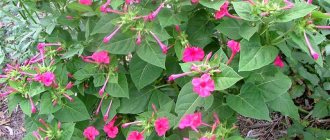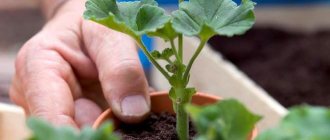Verbena is a beautiful and unpretentious plant with which you can create an amazing and bright flower garden. Now the most popular varieties are: Buenos Aires (Bonar), hybrid, straight, hard, Canadian. The flower is perennial, but in our country it is most often grown as an annual. If you want to contemplate a beautiful flower bed at your dacha or the site of a private house, then now is the time to start growing verbena from seeds at home.
Characteristics of hybrid verbena
The size of the bushes can vary from 10 cm for dwarf varieties to 60-70 for tall ones. The stems are often erect, but creeping ones are also found. The shoots are tetrahedral, covered with short hairs.
The root system is quite branched, growing 15-25 cm in depth. The leaves are grouped below, at the base of the stem, their shape can be oblong, rounded at the end, triangular and heart-shaped. The color of the ground part has a deep emerald hue. Inflorescences - umbrellas consist of many small flowers of a wide variety of colors. It includes colors such as blue, purple, red, white, pink, cyan and peach. After flowering, a fruit is formed in the form of a nut or capsule.
Use in garden design
Verbena Buenos Aires (Bonar)
Hybrid varieties, having a compact root system, get along well with other plants:
- cereal and bluegrass herbs;
- petunia;
- geranium;
- juniper and other conifers.
Creeping verina
The following varieties are traditionally used to decorate a site:
- “Ideal” is distinguished by early flowering, the color of the caps is cherry, pink, red, white, blue, lilac;
- “Star dance” of all kinds of flowers, the buds have a colored center (ampelic, drought-resistant verbena);
- “Carousel” is a medium-sized shrub that looks like a primrose (white, blue, purple, pink, red colors are available, there are varieties with a colored eye);
- “Fancy” is a tall verbena that forms a dense bush due to numerous side shoots.
The search for a variety is not limited to this list. Large-flowered “Etna”, “Julia”, “Cardinal” look gorgeous in flower beds. For balconies choose compact types “Crystal”, “Dazler”, “Amethyst”.
Important! When choosing a variety, the main criterion is the height of the plants. Combining dwarf, low-growing and tall verbenas they create amazingly beautiful borders near buildings and steam paths.
Photo of a hybrid variety
Next you will see a photo of a herbaceous plant for open ground, hybrid verbena:
Why is seed propagation the best way?
Successful propagation of a flower using seeds is only possible if the seeds are of high quality. Then almost 100% germination is guaranteed.
There are several brands of high-quality seeds on the Russian market:
- Aelita;
- Gavrish;
- SeDek;
- Search;
- Russian vegetable garden.
If the plant is planted in open ground, it reproduces by self-seeding.
After flowering, verbena produces seeds that can be carefully collected and planted next year. Flower germination in this case lasts up to 5 years.
Landing
Produced at the end of spring, when warm weather sets in. At this time, verbena seedlings are planted in a permanent plot. The place should be well lit throughout the day so that the light-loving beauty feels comfortable. You cannot plant a hybrid species in lowlands where moisture flows after rain or in wetlands. The plant is a drought-resistant species that does not tolerate constant dampness.
Read more about planting perennial verbena and growing the plant here.
Land preparation
The flower does not have any special requirements for the composition and reaction of the soil, but feels better on fertile loamy soil with a loose structure.
Heavy dense soil is mixed with sand and peat, and drainage from any stones is laid at the bottom of the planting hole. This will protect the roots from stagnation of water and rotting.
The soil must be mixed with humus and mineral fertilizers containing potassium and phosphorus. Bushes are planted in this nutrient mixture and the soil around is lightly compacted.
How to care for verbena seedlings
Caring for seedlings of this flower after sowing is not very different from the principles of caring for seedlings of other vegetable and flower crops. The main points of growing plants from seeds before and after germination are standard.
You need to care for verbena seedlings as follows:
- After sowing, the container with soil and seeds must be covered with film, glass or a lid (to create a mini-greenhouse). Every day, until seedlings emerge, you should ventilate the crops for 20-25 minutes, removing the covering material. Don't forget to remove condensation from it with a napkin.
- Immediately after sowing, it is recommended to place the container in a place with a temperature of +22-25°C.
- After the first shoots appear, it is necessary to remove the covering material . And in order for young plants to more easily tolerate changing conditions, this must be done gradually - on the first day, the film or glass is removed for 30 minutes, and then the time increases and after a few days it is completely removed.
- After the emergence of seedlings, the temperature regime also changes - now the temperature should be maintained in the region of 15-18 degrees Celsius.
- Lighting is very important for young seedlings. The optimal length of daylight hours is 12-14 hours , so it is necessary to provide additional light to the seedlings.
- Watering before germination of seedlings should be done from a spray bottle. Moisture should be added regularly so that the soil is always moderately (!) moist.
- After the emergence of seedlings, it is necessary to water at the root , using, for example, a syringe. Water should not get on the plants themselves. Plants should not be over-watered, so water after the top layer has slightly dried.
By the way! With proper care, the first shoots of verbena will appear in 7-10 days!
Care
It does not present any particular difficulties, since hybrid verbena is not a capricious plant at all.
Watering
Moderation and regularity are the basic principles of the event. Watering is carried out at the root during dry periods with an interval of at least 5 days. From mid-July the procedure can be further shortened.
Air humidity
The tropical guest tolerates dry air well for a long period, so there is no need to artificially increase the humidity. You should not spray during flowering, so as not to get unsightly brown specks on the delicate petals.
Top dressing
Organic matter must be added once, during planting. If verbena receives a lot of nitrogen compounds, it will begin to increase the green mass of leaves and stems. Having spent all the energy on this, it will no longer be able to bloom.
To stimulate active abundant flowering, it is necessary to periodically feed the plant with complexes of microelements.
Thermal mode
Hybrid verbena tolerates any heat well, but does not like cold weather.
Even a drop to 0° will be disastrous for her.
In hot weather, it is recommended to loosen the soil after watering to provide the roots with normal ventilation and avoid severe drying out and, as a result, compaction.
Sowing: step-by-step instructions
Properly grown seedlings will produce high-quality flowers that will decorate any garden or home. After purchasing seeds, you need to prepare the soil and pot. It is good to plant verbena in a ready-made peat-based mixture. You can buy it in a store or make it yourself.
To prepare the soil you will need:
- 4/7 peat;
- 2/7 garden or vegetable land;
- 1/7 river sand.
After preparing the mixture, it needs to be disinfected: the earth is steamed in a double boiler or heated in the oven for an hour.
For seedlings, small pots with drainage holes are suitable, which can then be covered with film.
Since the seeds germinate unevenly, before planting they are treated with a growth stimulant and stratified. The stratification procedure is carried out as follows:
- Spread the seeds on damp gauze.
- Pack in film.
- Place in the refrigerator for 5 days.
Step-by-step instructions for planting seeds:
- Moisten the prepared soil.
- Place the seeds in rows at a distance of 2-3 cm from each other if planting is carried out in a common pot. If the seedlings are in different pots, then plant 3-4 seeds in each.
- Sprinkle the seeds with soil (a very thin layer).
- Spray with a spray bottle.
- Cover with film or a lid to create a greenhouse effect with a temperature of +20...25°C.
Then the seedlings remain in place until the first shoots.
Growing from seeds
To get a flowering plant in summer, seeds are sown for seedlings no later than February. To do this, use small containers filled with loose substrate. You can buy ready-made universal soil or mix sand with peat and garden soil. The seeds are evenly placed on the surface and are not covered with soil on top. Instead, the boxes are covered with glass or plastic film. Sprouts appear within 13-15 days.
When the first pair of true leaves appears, the seedlings can be planted in separate cups or bowls.
Preserving verbena in the house in winter
The flower will overwinter on a glazed loggia, insulated balcony or winter garden at temperatures up to +15°C. It is advisable to plant bushes in containers for wintering before the cold weather. The stem is shortened to 10 cm. The earth must be regularly moistened so that the earth does not crack. The plant is kept in the dark for a month at the very beginning of spring. After this, they take it out into the light, loosen it, and feed it. By the onset of warm days, the bush will be ready to be moved to the site. Cuttings are taken from overwintered hybrids for vegetative propagation.
Growing from cuttings
An easy and affordable way to obtain planting material yourself. Cuttings are harvested in the fall, during the harvesting of faded plants. They need to be dug up along with a lump of soil and placed in a suitable container. For wintering, the bushes are sent to a fairly cool room with a temperature no higher than 7-9° . This could be a glazed balcony, cellar or basement.
For subsequent planting outside, the bushes are taken out in March. Their healthy apical shoots containing 5-6 axillary buds are cut off. Sections are disinfected with activated carbon powder or wood ash.
The finished cuttings are placed in a substrate of sand, peat and vermiculite, buried to the bottom leaf bud. To speed up root formation, containers are placed in a greenhouse or covered with plastic bottles. Roots begin to appear already in the second or third week.
Read more about growing verbena from seeds and propagating the flower by cuttings at home here.
Basic steps for planting verbena seeds for seedlings
In order to correctly perform the procedure and plant the seed, you should know the technology of the entire process. Step-by-step sowing instructions will help in this matter.
Step one: choosing a container
Any container is suitable for growing verbena seedlings: a general container - a wooden or plastic box, some kind of wide and shallow bowl, and single containers - plastic cassettes, peat pots or tablets, plastic cups.
Step two: soil preparation
To plant verbena seeds, you can buy universal soil for flower seedlings or prepare a soil mixture with your own hands. The main thing is that the land meets certain characteristics.
Important! Basic soil requirements: it must be neutral, loose, light, and have excellent air and water permeability.
You can prepare soil for sowing verbena seeds at home by mixing the following ingredients:
- clean river sand (0.5 parts);
- peat (2 parts).
- soil from the garden (1 part);
- wood ash (added in the ratio of one glass per four liters of soil).
If you decide to plant the seeds in purchased soil , then before use it is recommended to add sand and ash to it (in the same proportion as described above).
By the way! You can add perlite to the soil (two glasses per 4 liters of mixture), it will improve the soil structure and make the soil more suitable for seedlings of this crop.
Before use, it is necessary to cultivate the ground. Can be disinfected with a solution of potassium permanganate, Fitosporin, Maxima. Or bake in the oven or steam over steam (for 30 minutes). And then be sure to sift through a sieve !
Step three: direct sowing
Having waited for the appropriate time, prepared the containers and soil, you should proceed to the event. Landing occurs according to the following scheme:
- Before sowing, it is necessary to treat the seeds in a growth stimulator, this will help them sprout faster (usually they sprout slowly). To do this, soak them for 20 minutes, for example, in a solution of the preparation “Zircon”, “Epin”, “Heteroauxin”.
- Fill the container with soil, pour warm water over it and level the surface.
- Pick up the seed with a wooden toothpick dipped in water and transfer it to the surface of the soil.
- Transfer all the seeds so that there is a distance of 2 centimeters between them (the gap will allow you to obtain plantings with normal density).
Advice! If you find sowing seeds with a toothpick too troublesome, you can fold a white sheet of paper, sprinkle seeds on the fold, and use the sheet to sow evenly. But don't put too many seeds in one place.
- Sprinkle the seeds with a small layer of soil on top, literally 2-3 millimeters.
- Spray with clean water from a spray bottle.
- And as a final planting step, you need to cover the container with film or glass.
Diseases
Hybrid verbena, like other varieties, is little susceptible to disease. But it can also be attacked by fungi and insects.
Powdery mildew
The fungus sets in high humidity amid warm weather. White blotches appear on the leaves, similar to spilled flour. Severe infestation causes their color to change to purple. Then the leaves fall off and the plant dies. The disease is treated with fungicides containing copper (Oxychom, Abiga-Pik, copper sulfate) and new combined systemic drugs (Vitaros, Ridomil Gold, Previkur).
Rotten
Verbena bushes can be attacked by almost any fungal rot. Among them are stem, black leg, root, gray. By cutting off all the affected parts in time and treating healthy tissues with fungicidal agents, you can save your flowers from the disease.
There are different types of verbena: finely cut, ampelous, medicinal, Buenos Aires. You can read about them on our website. We have also prepared information about the beneficial properties, uses and contraindications of medicinal verbena.
How to determine sowing time?
The very first task faced when wanting to grow verbena is determining the exact planting time.
In most situations, the best time to work with seeds is in March.
In this case, the transplant will take place around mid-May, since the plant needs at least 60 days to grow and become sufficiently strong. It is very important that the return frosts outside after winter have already passed, and that at night the temperature remains consistently above zero.
ON A NOTE. Climate features: sowing dates may shift depending on the region where Verbena is grown.
In the south, seeds are planted as early as mid-February and transplanted outside from early to late April. In the northern regions, in the Urals, and Siberia, seeds are planted in April in order to replant the flower at the end of May or even the beginning of summer.
Transfer
For verbena, a light to medium soil substrate is suitable, composed of leaf, peat, humus soil and partly sand.
- Before replanting, you can disinfect the soil with any fungicide to protect against fungal diseases.
- Plants should be replanted in dry or slightly moist soil, since the root system is not injured and will take root well with subsequent watering.
- In pots (plant pots), cover the drainage hole with a layer of small river pebbles and fill the container with soil mixture.
- After everything is ready for replanting, the plant is carefully removed from the previous substrate, the rhizomes are inspected, and damaged areas are removed. After this, the plant is lowered into the soil poured into the pot and covered so that the root collar is slightly lower from the edge of the pot and is not covered with soil.
- A newly planted plant should be watered sparingly.
- Basic rules for caring for a young plant require bright lighting for 8-10 hours a day and good air circulation.
Pros and cons of the method
The perennial plant can be planted exclusively in regions with warm climates. But verbena is found as an annual crop in regions from the middle and northern zone. Reason: low frost resistance. Severe frosts kill the root system.
Takes root in gardens and public flower beds. Planted with seedlings obtained by seed propagation. Outwardly it looks like a delicate flower of various colors.
Flowering occurs in early summer. It blooms at the first frost. The plant can be tall (1 m or more) and short (up to 20 cm). Depends on the type and variety.
The positive aspect of growing verbena through seedlings attracts even more gardeners to plant the crop:
- long flowering;
- no difficulties in obtaining seedlings;
- ease of care;
- you can form a pattern in advance from purchased varieties;
- the number of seedlings before transshipment to a permanent place is known.
Brief description of cultivation
- Landing . Stratified seed material is sown for seedlings in March–April. Planting of seedlings in the garden is carried out from mid to late May or in early June.
- Bloom . Starts in June and ends in October.
- Illumination . Grows well both in shade and in bright or diffuse sunlight.
- Soil . It can grow in any soil, but nutritious loam is best suited.
- Watering . Until mid-July, water systematically and moderately. Starting in August, a gradual reduction in watering is carried out.
- Fertilizer . Throughout the season, 3 or 4 feedings are required; for this, a mineral complex with a low nitrogen content is used.
- Reproduction . Most often by seed, more rarely by cuttings.
- Pests . Aphids, spider mites and nematodes.
- Diseases . Blackleg, gray mold, powdery mildew, root rot and spotting.
All about verbena. From sowing to flowering!
When to plant seedlings in open ground?
In most situations, the weather is good for growing Verbena outdoors no earlier than mid-May . If we talk about southern areas, then this period sometimes occurs even in mid-April. To the north - later, at the end of May or early June.
The most important thing is that there is no frost at night.
Seedling bushes are planted together with a lump of earth. It is advisable to maintain a distance of 30 cm between bushes.
REFERENCE. Monitoring Verbena in open ground is not difficult. First of all, try not to flood the bushes, since the flower is drought-resistant. The optimal regime is about 1 watering per week in normal weather and up to 2 in hot weather. Secondly, weed the beds and loosen them more often.
When to plant depending on the region?
In most of Russia, Ukraine, and Belarus, Verbena seeds are planted to grow seedlings throughout March. Only a few, the most experienced gardeners begin work in February. They do this so that at the beginning of May, and sometimes even in April, they can observe the flowering of this plant in their open garden. However, it is important to remember that you should only replant bushes when there is no frost at night. If, according to forecasts for the middle zone, the onset of stable spring heat is expected in April, then you can start growing seedlings early.
REMEMBER that in February in the middle zone, seedlings may still not have enough light, and Verbena is a light-loving plant. The solution is to organize artificial additional lighting for 4-8 hours a day (up to 12 hours of daylight are needed in total).
In the south of Russia and Ukraine, Verbena seeds are usually planted at the end of February and less often at the beginning of March. This is because already in April it is warm and light enough for the plant to be safely transplanted outside.
But in the northern regions the deadlines are expected to come later. To the north of the Moscow region, as well as in the Urals and most of Siberia, these flowers are sown in early April in order to be replanted in May-June, when more or less stable weather sets in without temperature changes for growing flowers.
Planting dates in 2022
The optimal time for planting verbena seedlings is March. However, if you can organize additional lighting to extend daylight hours to the required hours, for example, with phytolamps or more economical LED lamps, then you can sow verbena seeds already in the second half to the end of February.
According to the lunar calendar in 2022
The Lunar calendar can help you choose the optimal date for sowing seeds.
So, favorable days for sowing verbena in 2022 according to the Lunar calendar are:
- in February – 1-8, 10-20, 25-29;
- in March – 2-8, 10-14, 29-31;
- in April – 1, 2, 5-7, 9, 17-20, 24, 25;
- in May - 2-6, 15-17, 20, 21, 25-31;
- in June - 2-4, 7-9, 11-14, 16-19.
Unfavorable days according to the lunar calendar for 2022 for sowing verbena are the following dates (Full Moon and New Moon days, as well as the period when the Moon is in Aquarius, because this is a barren and dry sign.
- in February - 9, 21-22, 23;
- in March - 9, 19-21, 24;
- in April - 8, 15-17, 23;
- in May - 7, 13-14, 22;
- in June - 5, 9-11, 21.
Popular varieties of verbena
Plants from the genus Verbenaceae have more than 250 species, which usually grow in the tropics and subtropics. Most of the varieties of this flower are hybrid varieties of South American origin, for example, the perennial verbena Delight, which are widely used in gardening and landscape design. Most often, annual plants with a wide variety of colors are used for planting. We know about 40 species of verbena, where both simple and hybrid varieties are found. Look at the article: Lobelia: growing the most famous varieties from seedlings.
Verbena Ideal
A beautiful, bright flower that attracts with a pleasant aroma on a warm evening. The plant is about 30 cm in height and comes in a variety of colors: cherry, pink, blue, red, white, purple. At the top of the head, the low-growing Verbena Ideal has a mass of spherical inflorescences, which are no more than 5 cm in diameter. Flowering begins in June and lasts until October. Verbena hybrid Ideal is often used to decorate garden beds, flower beds or for cutting.
Since the variety is cold-resistant, low-growing verbena is grown from seeds in sunny places where the soil is loose and there is no stagnant water. Planting seeds for seedlings occurs in February or early March, the most optimal temperature for germination is about +2 degrees. After 10 days, the first shoots appear. When the young seedlings grow up, they are transplanted to a permanent place, keeping a distance of 30 cm between them.
Verbena Peaches and Cream
An excellent hybrid variety that appeared several years ago. Its flowers are numerous and expressed in pastel, soothing tones that stand out against the bright green foliage. To get larger verbena flowers: Growing from seeds must be done correctly. 12 weeks after planting the seeds in the ground, the first flowering begins, which resembles a real carpet.
However, in order for the cultivation of Peaches and Cream verbena to give good results, the seeds are stored in the refrigerator and then planted in boxes covered with film. The temperature should be at least +24 degrees. The first shoots usually appear after 10-15 days, after which the air temperature should be reduced to +16 degrees. Seedlings are transplanted into the ground when there is no threat of frost. The flower loves fertile, loose soil and well-lit areas. Watering should be regular but even. To make the bush more branched, it is pinched, and it is also necessary to remove faded flowers in a timely manner.
Verbena Bonarskaya
A fairly large, branching plant that can reach a height of up to 120 cm. Its long, strong peduncles hold powerful umbrella-shaped inflorescences, which consist of a mass of small, purple flowers.
Since the variety does not withstand frost, Bonarskaya verbena is grown from seeds using the seedling method, that is, the flower grows as an annual.
As an adult, it can withstand light frosts and requires shelter. Thanks to this, verbena can be planted in early spring or left in the ground until the first frost. When decorating flower beds, the plant is planted in dense bushes that cover the entire space, filling it with bright colors. This hybrid variety goes well with other contrasting plants, emphasizing their beauty and color.
The cultivation of hybrid verbena by seedling method begins in March or April. To speed up the germination of seeds, they are soaked in warm water for 2 hours and then laid out on a damp cloth. After this, they are placed in the refrigerator for several days, that is, the stratification process is performed. Next, the swollen seeds are sown in the ground and after 2-3 weeks the first shoots should appear. When the first leaves appear on the sprout, they are planted in peat pots.
Young seedlings are pinched and planted in the soil only after hardening. Plants are placed at a distance of 25 cm from each other. For planting, it is advisable to choose loose, fertile soil and a well-lit place; waterlogging is not acceptable. During cultivation, watering should be moderate. The tops of the seedlings need to be pinched, it is also very important to remove faded flowers, and complex mineral fertilizers must be applied to the soil every 4 weeks. The first flowering begins at the end of June and ends just before frost.
Verbena Cotton Candy
This is a hybrid variety of verbena, which is an annual and is used for planting in flower beds, borders, borders, balcony boxes or containers. In appearance, Cotton Candy verbena has the appearance of a compact plant with thin, branched stems. At its tops there are umbrella-shaped, lush inflorescences, which consist of many snow-white flowers. They look great in hanging flowerpots, where they can be combined with other hanging plants.
Regarding how and when to plant verbena, you need to take into account that the plant tolerates temperature changes well and is resistant to bad weather conditions, that is, wind, rain, hail. All summer it pleases its owners with abundant flowering. They begin sowing its seeds in March, and after three weeks the first shoots will appear. Since seedlings can get sick due to excess moisture, it is advisable to spray them after the soil dries. Young bushes emerge after the first two leaves appear, and seedlings are planted in open ground in May, the distance between them should be about 30 cm.
Verbena Lucifer
An unpretentious, cold-resistant plant that is grown as an annual. Finely dissected verbena is about 25 cm in height, has many branches and is distinguished by abundant flowering. Its flowers are bright scarlet, have a regular shape and are collected in large, corymbose inflorescences, which reach 6 cm in diameter. The flower is used as a potted plant and for decorating flower beds; it is grown in boxes and on balconies. Bushes look especially beautiful in a group with other flowers. Verbena can withstand adverse weather conditions and tolerate temperature changes.
The cultivation of Lucifer verbena from seeds to seedlings begins in March or April. When the first two leaves appear, the seedlings are transplanted into separate peat pots, and in mid-May they are planted in open ground. The distance between the bushes is about 25 cm. The flower loves loose, fertile soil and an open, sunny place; waterlogging of the soil is prohibited. Pinching the tops is necessary, which will make the bush more lush and flowering abundant. It is also important to remove faded inflorescences and periodically feed the flower with complex mineral fertilizer. The first flowering begins at the end of June and lasts until the first frost.
Verbena Lady Dream
The Lady Dream variety is the best solution for decorating a flower bed. The plant has compact dimensions and many branches, the bush is no more than 30 cm in height. It is covered with bright, pink flowers, from which a delicate, pleasant smell emanates. When compared with other varieties in terms of flowering duration, Lady Dream verbena has no equal, because it blooms from the beginning of June until the very frost, without losing its beauty. It is ideal for decorating flower beds, flower beds, balconies or loggias.
Regarding the peculiarities of growing verbena of this variety, everything is done according to the standard scheme. Sowing of seeds begins in March or April, but they are pre-soaked in a damp cloth. After two hours, they are sown in boxes and covered with glass. When the first few leaves appear, the seedlings dive into peat pots. In mid-May, young bushes are planted in open ground.
Verbena Quartz
An early-flowering, low-growing, hybrid variety that blooms a week earlier than other varieties and delights with its large inflorescences. Grandiflora verbena is no more than 35 cm in height; its flowers are bright, clove-shaped, large, and have a pleasant aroma. Verbena Quartz blooms from the first days of June until the first frost. Since the bush has many side shoots, it blooms abundantly.
Regarding the conditions of detention, hybrid pink verbena is a light-loving, drought-resistant, cold-resistant plant. It is used for planting in pots, as a potted crop, or for decorating flower beds in the garden. Grows well in greenhouses and winter gardens.
Verbena Blue Night
A beautiful, low-growing plant with bright, abundant flowering and green, openwork foliage. The flower is no more than 30 cm in height and is distinguished by a mass of lush branches. Its inflorescences are blue-violet, no more than 5 cm in diameter and are collected in dense inflorescences. This variety is characterized by long, early flowering, which begins at the end of May. Blue Night verbena is not demanding in terms of care; it tolerates light frosts and drought, so it is often used for planting on balconies, borders or in gardens.
There are some secrets to growing verbena of this variety. For example, you need to plant seedlings in sunny, open areas where there is no wind or draft. It is not advisable to water the first seedlings, but only lightly spray the soil, since this particular variety tolerates waterlogging of the soil the worst.
When the seedling has several leaves, it can be transplanted into open ground, the distance between plants is about 30 cm.
Verbena Bright Sparks
Beautiful annual verbena, which is distinguished by the presence of a mass of branches and long, abundant flowering. This variety is resistant to powdery mildew, unfavorable conditions and unpretentious to the soil. It is often used to decorate flower beds, flower beds, boxes and ridges. Seeds for flower seedlings are planted in March or April, but they are moistened in advance so that they swell. Only after this are they planted in boxes and covered with film or glass. With the appearance of the first leaves, the seedlings are ready for planting in the ground; planting of seedlings usually begins in mid-May.
When compared with other species, Verbena Bright Sparks is more capricious, as it loves fertile, calcareous, loose soil, moderate watering and well-lit areas. In addition, it needs pinching and regular removal of dry flowers, and it also needs fertilizing with mineral fertilizers. Its flowering begins in June and lasts until frost.
Verbena Garnet Star
A cold-resistant, drought-resistant variety that is distinguished by long-term flowering, decorative appearance and unpretentiousness to the soil. Many gardeners choose to grow verbena seedlings from the seeds of this variety in order to decorate flower beds and add new, bright colors to existing flowers. Quite often, Pomegranate Star verbena is used as a container crop, as it is able to adapt to growth in a limited space. The only condition for its abundant flowering is feeding and regular watering. Very often, flower stems are used for cutting and making bouquets.
Seeds of this variety are planted in March for seedlings, and after three weeks they germinate. Moisturize the seeds only by spraying, otherwise they will quickly rot. The seedlings germinate after the formation of several leaves, and are planted in open ground in May, the distance between the bushes is at least 30 cm.
Verbena Tango
A fairly compact plant, which is only 20 cm in height, its inflorescences are quite large and are about 8 cm. This annual plant is readily used to decorate borders, flower beds, borders, and for planting in boxes or containers. At the top of the head, Tango verbena has lush, bright inflorescences, which consist of a mass of bright pink flowers. They look great in hanging pots and complement any hanging plants. Regarding propagation, the technology for growing Tango verbena is the same as that of other varieties. We advise you to look at the article: Begonia: species for growing in open ground and apartments.











